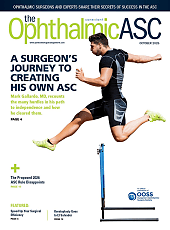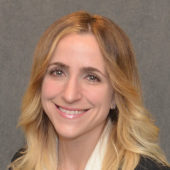Presbyopia is an unavoidable condition of the aging eye, making it a central concern for general ophthalmologists and refractive surgeons alike. In this interview, Kathryn Hatch, MD, shares her insights on the latest surgical and nonsurgical approaches to treating presbyopia, from refractive lens exchange to innovative intraocular lens (IOL) technologies. She also discusses the importance of patient selection, expectation management, and the evolving landscape of presbyopia treatment options.
Key Takeaways
1. A personalized, age-dependent approach is essential
2. Technology is expanding options—but patient expectations must be managed
3. Nonsurgical options and testing play a vital role
Ophthalmology Management: Tell us about your experiences treating presbyopia.
Kathryn Hatch, MD: I’ve been treating presbyopia as long as I’ve been an ophthalmologist. It affects all of us. There are close to 130 million Americans with presbyopia right now. So, if you’re an ophthalmologist, and certainly if you’re a refractive surgeon, it’s front and center for treatment.
OM: How do you approach surgery for presbyopia?
KH: Age matters so much, typically, because we know that the natural lens is on a trajectory of aging. Usually, patients in their early to mid-40s start to develop symptoms of presbyopia and start to need reading glasses. This is very different from a patient in their 60s or 70s who has cataract formation. I think it also matters quite a bit what their refractive errors are. Is the patient myopic, are they are nearsighted, are they hyperopic? Also, what are their goals? There’s a lot to unpack when we are meeting with patients who are looking to treat their presbyopia from a surgical perspective, because it certainly isn’t one-size-fits-all.
I had a high myope, for example, who was in their 50s with minimal sign of cataract. Certainly, we could think about the different options, but with our advanced technology lens implants, refractive lens exchange has become very desirable for a lot of patients seeking full-range vision. We have so many wonderful IOL technologies now: monofocal, multifocal, toric, extended depth of focus, accommodative lenses, and the Light-Adjustable Lens (RxSight, Inc). Yet we should be mindful of the increased risks of retinal problems, especially for a myope who might be at risk of retinal detachment. For that patient, we might wait until they’re older or they develop a cataract. But I do think that phakic IOLs are an option for high myopes in their early 50s.
Phakic IOLs in people over the age of 45 are technically considered off-label, but they’ve been a nice bridge for some patients. It’s not necessarily treating their presbyopia directly, but if you sometimes do a little bit of mini monovision, making one eye a little bit more nearsighted or able to read cell phones, for example, and the other eye for distance, then patients can do well with that.
Monovision is also a potential avenue for presbyopes, but not everybody tolerates that. That’s something that needs to be tried at home for a period of time. Certainly, if someone tolerates monovision well, that could be a good option with either laser vision correction or phakic IOLs if the patient is highly nearsighted.
Hyperopic patients can be very good candidates, especially when they’re at an appropriate age to have refractive lens exchange. Those patients are really happy when you treat [the hyperopia] and then choose some sort of multifocal or extended-depth-of-focus lens that can give them full-range vision. It’s very important that we first evaluate the patient’s age, lens status, and refractive errors, then spend time with them and get to know their goals. So much of what we do is setting expectations.
This is where the art of medicine comes in. You have to get to know people, learn what their goals are, and then match them with the appropriate surgery and technology for their needs and lifestyle. All technologies have potential benefits and limitations—there isn’t necessarily a perfect solution. We can’t give somebody their natural lens back. When we do surgery, we’re using artificial technologies and certain techniques that are going to [result in vision] that’s different from the lens they were born with. We have to make sure patients really understand this.
OM: What percentage of your surgeries are elective?
KH: I would say maybe 25% don’t have cataracts.
OM: Have you seen an increase of younger patients in recent years?
KH: Yes, now that we have implant technologies like the Light Adjustable Lens (LAL), which can be finetuned to suit the patient post-surgery before locking in the prescription, as well as newer, non‐diffractive and wavefront‐shaping technologies that extend the depth of focus without splitting light, patients are requesting these technologies younger and younger. I usually like to wait until they are at least 45 years old, but there are some people in my area doing them even younger than that. But, again, patients’ refractive error is a very important consideration to avoid retinal detachment.
I do have a lot of patients in their late 40s and early 50s who are coming in for refractive evaluations. They have reached a point where they want to do something about their presbyopia. They might also have more income to afford various options. However, this can be very time-consuming because patients often need to be educated that LASIK isn’t necessarily targeting presbyopia specifically in all situations.
OM: What has been your approach with drops or other nonsurgical options?
KH: Presbyopia drops can sometimes be a nice bridge to surgery. Many of these eyedrops aren’t FDA approved, so we can’t offer them yet, but that’s also something that could be considered when we have more available to us. And, of course, glasses and contact lenses are the other nonsurgical option. Sometimes avoiding surgery is the right decision for a patient, depending on their risk and expectations. Laser scleral microporation is being investigated, but there are still unanswered questions about where it fits into the treatment paradigm.
OM: Do you include these kinds of procedures in your marketing, as far as promoting your practice?
KH: Yes. On our website we list information about what we’re offering, such as specialty lenses.
OM: Are there common complications with certain surgeries that you see, and how do you deal with those, if so?
KH: Refractive lens exchange has some of the same risks as cataract surgery, so we always talk with patients about the common things that could happen. Sometimes patients have more floaters, for example. Adaptation, which I wouldn’t consider a complication, is an expectation that patients have to understand and agree to, when we’re talking about multifocal lenses. Patients have to get used to them. Some people get used to multifocal lenses very quickly and easily, and others take a little longer. Sometimes patients will require additional procedures to get to their end point, such as a laser capsulotomy or fine tuning residual astigmatism. These are all things that need to be addressed to get patients at an optimal vision perspective.
Also, we always have to manage and optimize ocular surface and dry eye. Many patients who have eye surgery have dry eye. It’s such an extremely common condition and it can affect refractive results, so that is something else that needs to be managed and not overlooked before and after surgery.
With something like monovision, we always have the patient test it out before we operate. We routinely will do a little bit of blended vision when we’re doing surgery, where it’s not a true monovision, but just a slight offset in one eye. It is common for patients’ vision to be different in each eye. However, true monovision is something the patient needs to experience and tolerate before having the surgery. Multifocal contacts are a way to test that, but some patients don’t tolerate those either. I do tell patients, even if you don’t tolerate multifocal contacts, it doesn’t mean you’re not going to like or tolerate a multifocal lens.
OM: Do optometrists often refer patients who are not happy with glasses or contacts?
KH: We definitely have optometry referrals, and although generally my patients are more conservative, we do see some who are innovative and want to try new things.
OM: Any final thoughts?
KH: Our IOL technologies are very good, but it’s very important to be able to manage patients who may have residual refractive errors or have some issue that comes up after surgery. Make sure patients are good candidates for an enhancement, for example, if they need that. Understand from a comprehensive perspective what somebody might need after. A general ophthalmologist can sometimes be less comfortable using these technologies for these reasons. The ophthalmologist needs to be comfortable using these technologies in terms of balancing the benefits and limitations. OM









